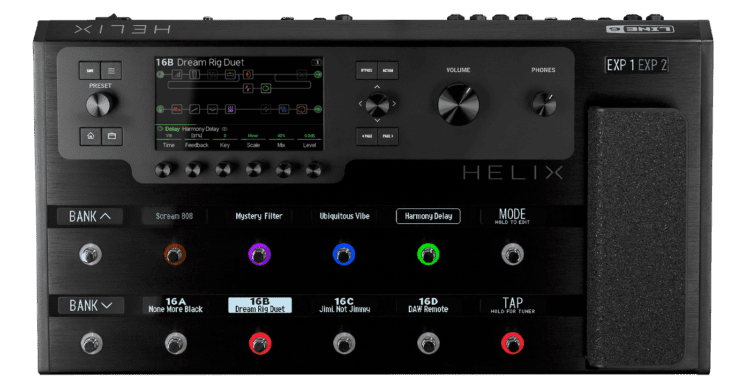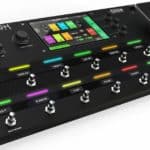Crafting the perfect tone is a never-ending quest for most guitarists.
Especially for those that really care about it.
In the context of this quest, there are many discussions among players.
On one side there are the purists that only use real physical gear and claim they can detect a fake digital copy from miles away.
On the other side, there are the more open-minded guys (no offense to purists) that will try just about anything that could improve their sound and quality of life, in terms of convenience.
But, in reality, and as opposed to this antagonistic picture I painted, there’s a place for both “real” and digital amps.
While real amps are the ultimate tool for getting a great tone, it’s indisputable that the Helix is a more convenient piece of gear because of its transportability and the number of amps, cabs, and effects it simulates. However, it takes some work to make it sound as good as an amp.
In this article, I will go in-depth about what makes the Helix a great alternative to a real amp, but also why physical amps are still a thing.
After leaving this page you will have a clearer idea about what could work better for you, in your different needs as a musician.
Are you ready to get started?
Let’s go!
How does the Helix work?
The Line 6 Helix is one of the best multi-effect platforms out there.
With it, you have at your disposal hundreds of simulated amps, cabs, and pedals.
All of this in the form factor of a floor pedalboard, or a digital plugin that can be run on your DAW.
On a very basic level, the Helix allows you to craft unique signal chains and store them.
There’s also the option to define certain changes to some of these presets and have them at a button’s reach.
Think for instance having your rig set up for playing rhythm, with a variation available for when you need to play a solo or incorporate a particular effect.
So, with this, the workflow usually is that you prepare a few different rigs at home, which can be completely different from each other, from metal amps to fender cleans, and then when you practice or play live, you switch between them.
Being a standalone multi-effects, the Helix needs to be plugged into a PA system, an audio interface, headphones, or a powered speaker to be heard.
Let’s talk about its pros and cons because nothing is completely magic in life.
Helix pros
Here are some of the good things the Helix does:
- A lot of amps, cabs, and effects available
- The ability to mix and match and create unique sounds
- Cheaper than buying all the gear it simulates
- Easily transportable and relatively lightweight
- Nice user interface to craft your sound
- Great feel and overall tone
- A big community of users that share tips and presets
- Helix native plugin available for your DAW
- New amps, cabs, and effects added periodically through firmware updates
Helix cons
Here are some drawbacks to the Helix:
- You won’t use most amps, cabs, and effects it comes with
- The sheer amount of options for each part of your rig makes it difficult to decide
- Although being cheaper than individual gear, it’s still an expensive unit
- The lack of a touch screen can make it feel a little bit old when setting up your sound
- The presets it comes with sound horrible
- For many people, the Helix is still a step behind real amps
- Players that are not very tech savvy might not like its workflow
- There’s no functionality that allows you to “capture” your own amps
- You will need a powered FRFR speaker to practice at home, or use headphones
Real amp pros
Here are some benefits of a real amp:
- Way simpler and easier to use than a multi-FX
- Sounds great out of the box
- Best sound and feel possible
- Combo amps are the ultimate plug-and-play solution
- It’s way easier to experiment with new sounds by mic’ing a real amp
- Can also work as your stage monitoring system
- Small tube amps might sound and feel better than the Helix at a fraction of the cost
Real amp cons
Here are some bad things about real amps:
- They are heavy and cumbersome to carry around
- Tube amps can be more expensive than the Helix
- Limited tonal possibilities
- For half stacks, you will also need to get a speaker cabinet
- Tube amps need regular maintenance
- Naturally noisier
- Prone to interference
- Require proper ventilation
- Tube amps require to be warmed up to sound properly
- Tube amps only reach their full potential at high volumes
Which is best for you?
Deciding on which kind of gear is better for you is a very personal process and will depend exclusively on your needs and the stage you are at as a player.
Here, in GearAficioinado I don’t intend on making the hard decisions for you, however, I always try to give you examples of different use cases to push you in the right direction.
For this particular topic, there are many alternatives and variables, but know that a lot of professional players choose digital units such as the Helix to play live and to tour due to its convenience, while they keep their real amps in the studio for getting the best tone possible when recording.
Let’s see some particular situations where you could choose one over the other:
- If you are on a tight budget a cheaper amp might be your only choice
- If you play a lot of shows in different venues, a Helix will be very convenient
- If you have a studio, or usually participate in high-end projects, an amp will sound better
- If you mainly practice and record at home, a Helix will be the best choice
- If you hate spending hours tweaking to get a proper tone, go for a real amp
- If you play many different genres and use a lot of effects, go for a Helix
- If you only intend on using one sound for most of your playing, get a specific amp for that

Hello there, my name is Ramiro and I’ve been playing guitar for almost 20 years. I’m obsessed with everything gear-related and I thought it might be worth sharing it. From guitars, pedals, amps, and synths to studio gear and production tips, I hope you find what I post here useful, and I’ll try my best to keep it entertaining also.





